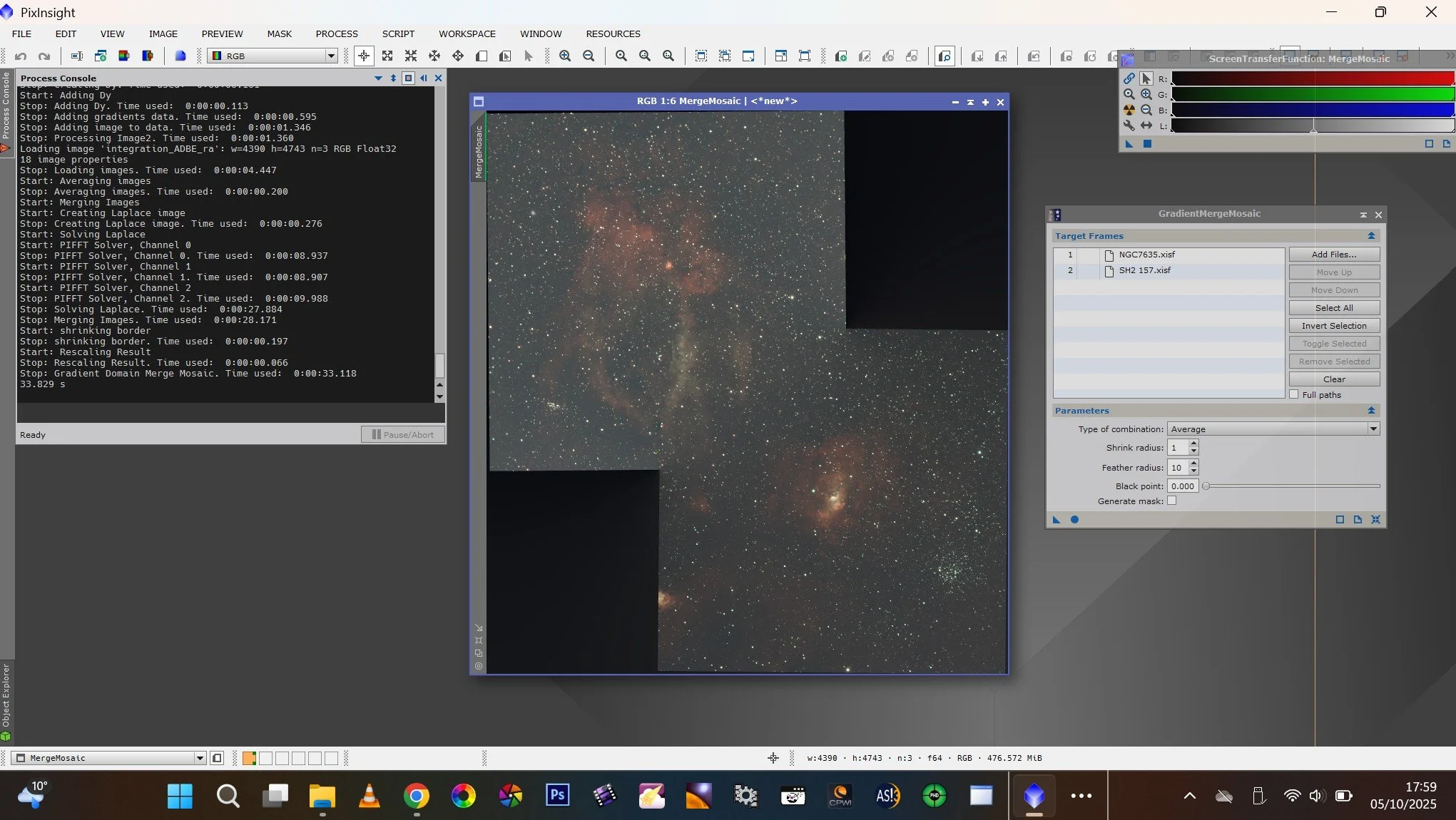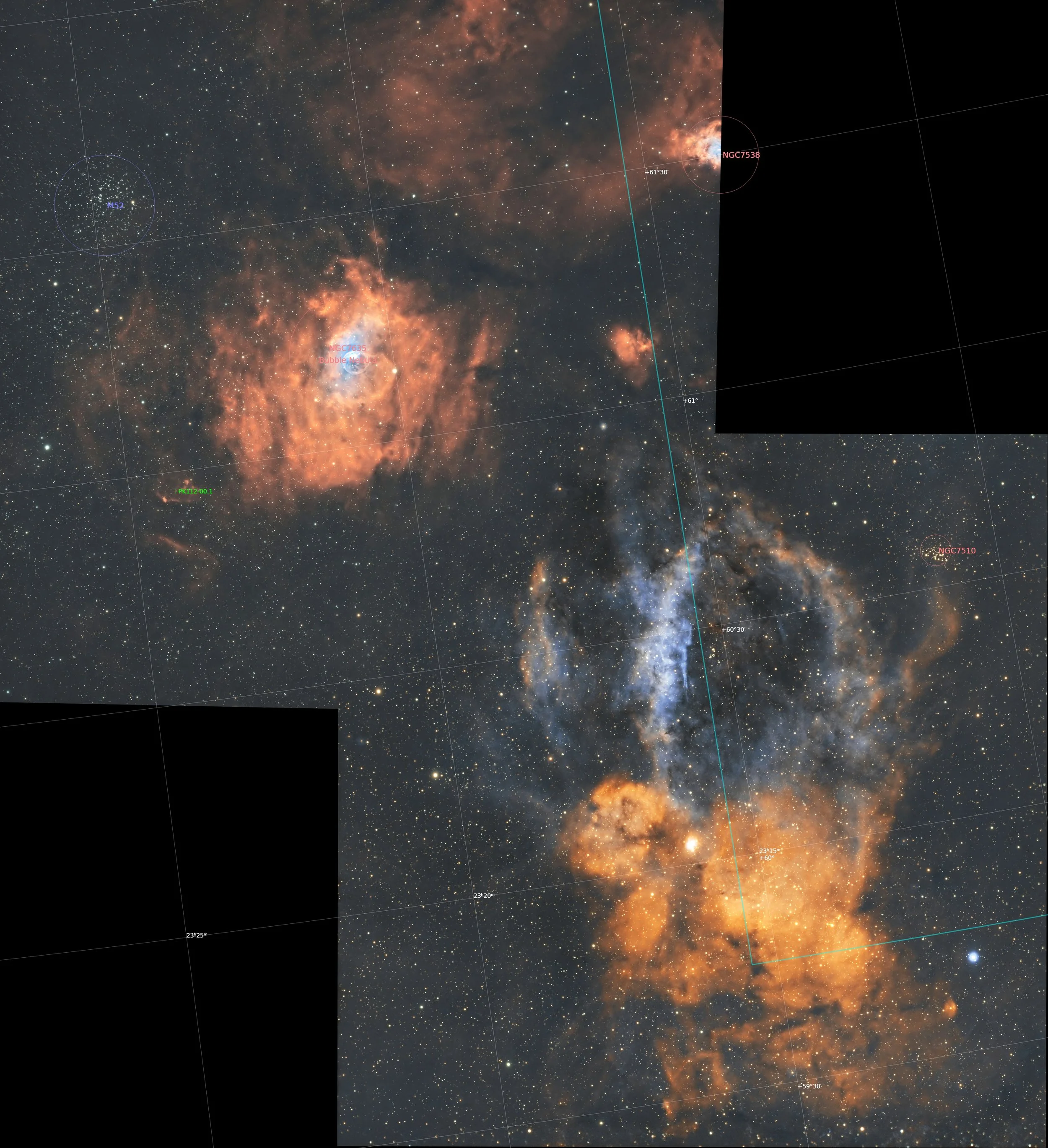Mosaic : Sh2-157 & NGC 7635 in Hubble Palette (SHO)
In a part of the sky, when you have objects close to each other but if the camera field is tight enough not to contain them all, a mosaic with several panels allows to have all the objects on a single image.
The mosaic with the coordinates of the objects is the best way.
The Lobster Claw (Sh2-157, or LBN 537) is a faint but sizable emission nebula visible in the constellation Cassiopeia. Its diffuse, lobster-claw-shaped appearance earned it its name.
It is located in the Perseus Arm and is directly connected to the large OB association Cassiopeiae OB2 (Cas OB2). The northern part of the cloud has a ring-like shape, caused by the stellar wind of several giant stars, while the southern sector appears excited by the luminous radiation of spectral class O stars.
Type O stars are the hottest, most massive, and most luminous stars in the universe, emitting light primarily in the blue and ultraviolet ranges, with a luminosity that can be a million times greater than that of the Sun.
Inside it lies a cluster of very young stars, representing the latest generation of a star-forming process that includes the Cas OB2 association itself and the neighboring open cluster NGC 7510.
Sh2-157 was catalogued by the astronomer Stewart Sharpless in 1959 as part of his “Catalogue of H II Regions”
Sharpless worked at the U.S. Naval Observatory Flagstaff Station, and he compiled this catalog using photographic plates from the Palomar Sky Survey.
NGC 7635 or Sh2-162 or LBN 549 or Caldwell 11 or Bubble Nebula is an emission nebula (HII region) and a stellar wind bubble about 8,000 light-years in diameter, located about 7,000 light-years from Earth, in the constellation Cassiopeia in the Perseus Arm of the Milky Way.
NGC 7635 was discovered in 1787 by German-British astronomer William Herschel.
Set up
Fra400 on Celestron AVX Mount
ASI533 MC Pro camera for imaging
ASI120 mini camera for guiding via Off axis guider Zwo
Antlia DuoBand 5 nm
Control via ASIAIR PLUS
Gain (ISO) : 101
Camera cooling : -10°C
Preprocessing and Processing : Pixinsight
The sessions
SH2-157 was taken in September 18th 2025
12 images of 15 minutes each
Total integration time : 3 hours
NGC 7635 was taken in October 2nd 2025
4 images of 10 minutes each
13 images of 15 minutes each
Total integration time : 3 hours 55 minutes
Preprocessing & Processing with PixInsight
Star Alignment of the 10- and 15-minute images (NGC7635)
Dynamic Crop
Integration of the 10- and 15-minute images into a single file
Auto DBE on NGC7635 & Sh2-157 to remove the light pollution from the background
Astrometry Image Solver on both images
Mosaic by Coordinates
Mosaic Merge to obtain the mosaic
BlurX Terminator in normal mode
StarX Terminator
Split of the mosaic to have the Red, Green and Blue channels, which I renamed S for Red, H for Green and O for Blue.
Noise X Terminator at 0.60 on each layer
Stretch of the S H O starless layers using Statistical Stretch
Stretch of the stars using Setiastro
SHO composition using Pixelmath :
On the Red channel : 0.3*H + 0.7*S
On the Green channel : 0.2*H + 0.2*S + 0.6*O
On the Blue channel : O
Layer assembly
Luminance extraction then Local Histo Equalization only on the Luminance, then injection of the Luminance to the starless
Various masks and curves
SCNR at 0.71
Range Selection then HDR Multiscale Transform at 6 to show the details
Slight general saturation
Stars reintegration using Pixelmath
Noise X Terminator at 0.40
After the stack of the images
After removing the gradient
Plate solving via Astrometry Image Solver
Mosaic by coordinates
The Mosaic
The Final Image
Due to the rather unpredictable weather, I was only able to make 2 panels, I hope to be able to complete the 2 missing panels (in black)
Framing on the Bubble Nebula
Framing on the Lobster Claw
Astrometry : Annotated Image
Clear Sky !
Leave a comment







